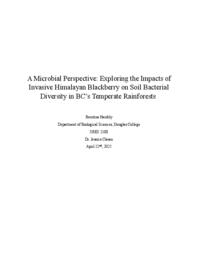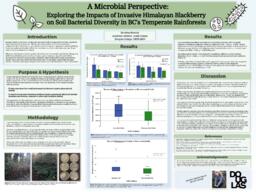Hambly, Berntina
Related Works
Content type
Digital Document
Description / Synopsis
Douglas College student research essay submitted as partial requirement for SRES 2100. Faculty sponsor to submit this research essay to DOOR: Dr. Jessica Classen.
While invasive plant species are known to negatively effect the environments they invade, research rarely focuses on the effects they have on soil microbiology, despite the critical roles microbes play within their ecosystems. Thus, this project sought to strengthen our understanding on such interactions, by questioning and exploring how invasive Himalayan Blackberry (Rubus armeniacus) affects soil bacterial diversity, in comparison to native Salal (Gaultheria shallon). To analyze bacterial communities in invaded versus non-invaded soils, soil core samples were collected in five different sites. The soil samples were processed and diluted, before being plated on nutrient agar. The pH and salinity of the soil samples were also tested. The relative abundance and diversity for each of the resulting plates were calculated. Following an independent samples t-test, it was found that there was no statistically significant difference in bacterial diversity of invaded-soils compared to non-invaded soils (p = 0.059), despite observed variations. Interestingly, further t-tests showed the bacterial abundance in invaded-soils was significantly higher than in non-invaded soils (p = 0.029), with no significant differences in the tested abiotic characteristics. This might reflect R. armeniacus’s adaptive ability to alter abiotic soil conditions other than pH and salinity, in ways that favors the growth of particular bacteria species; in turn contributing to their own success.
Origin Information
Content type
Digital Document
Description / Synopsis
While invasive plant species are known to negatively effect the environments they invade, research rarely focuses on the effects they have on soil microbiology, despite the critical roles microbes play within their ecosystems. Thus, this project sought to strengthen our understanding on such interactions, by questioning and exploring how invasive Himalayan Blackberry (Rubus armeniacus) affects soil bacterial diversity, in comparison to native Salal (Gaultheria shallon). To analyze bacterial communities in invaded versus non-invaded soils, soil core samples were collected in five different sites. The soil samples were processed and diluted, before being plated on nutrient agar. The pH and salinity of the soil samples were also tested. The relative abundance and diversity for each of the resulting plates were calculated. Following an independent samples t-test, it was found that there was no statistically significant difference in bacterial diversity of invaded-soils compared to non-invaded soils (p = 0.059), despite observed variations. Interestingly, further t-tests showed the bacterial abundance in invaded-soils was significantly higher than in non-invaded soils (p = 0.029), with no significant differences in the tested abiotic characteristics. This might reflect R. armeniacus’s adaptive ability to alter abiotic soil conditions other than pH and salinity, in ways that favors the growth of particular bacteria species; in turn contributing to their own success. Poster submission was sponsored by Dr. Jessie Clasen, (Science and Technology Department) and was presented at the New Westminster campus on April 10, 2025, for Student Research Days 2025.
Origin Information


